Chad
Republic of Chad
| |
|---|---|
Motto:
| |
| Mahamat Déby | |
| Succès Masra | |
| Djimadoum Tiraina | |
| Legislature | National Transitional Council[4] |
| Independence from France | |
• Colony established | 5 September 1900 |
• Autonomy granted | 28 November 1958 |
• Sovereign state | 11 August 1960 |
+235 | |
| ISO 3166 code | TD |
| Internet TLD | .td |
Chad,[a] officially the Republic of Chad,[b] is an independent state at the crossroads of North and Central Africa. The landlocked country is bordered by Libya to the north, Sudan to the east, the Central African Republic to the south, Cameroon to the southwest, Nigeria to the southwest (at Lake Chad), and Niger to the west. Chad has a population of 16 million, of which 1.6 million live in the capital and largest city of N'Djamena. With a total area of around 1,284,000 km2 (496,000 sq mi), Chad is the fifth-largest country in Africa and the twentieth largest nation by area in the world.
Chad has several regions: the
Beginning in the 7th millennium BC, human populations moved into the Chadian basin in great numbers. By the end of the 1st millennium AD, a series of states and empires had risen and fallen in Chad's Sahelian strip, each focused on controlling the
While many political parties participated in Chad's legislature, the
Chad ranks the 2nd lowest in the Human Development Index, with 0.394 in 2021 placed 190th, and a least developed country facing the effects of being one of the poorest and most corrupt countries in the world. Most of its inhabitants live in poverty as subsistence herders and farmers. Since 2003 crude oil has become the country's primary source of export earnings, superseding the traditional cotton industry. Chad has a poor human rights record, with frequent abuses such as arbitrary imprisonment, extrajudicial killings, and limits on civil liberties by both security forces and armed militias.
History
Early history
In the
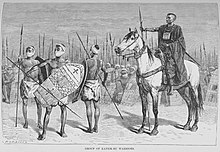
For more than 2,000 years, the Chadian Basin has been inhabited by agricultural and
French colonial period (1900–1960)
French colonial expansion led to the creation of the Territoire Militaire des Pays et Protectorats du Tchad in 1900. By 1920, France had secured full control of the colony and incorporated it as part of
The French primarily viewed the colony as an unimportant source of untrained labour and raw cotton; France introduced large-scale cotton production in 1929. The colonial administration in Chad was critically understaffed and had to rely on the dregs of the French civil service. Only the Sara of the south was governed effectively; French presence in the Islamic north and east was nominal. The educational system was affected by this neglect.[17][23]
After
Tombalbaye rule (1960–1979)
Two years later, Tombalbaye banned opposition parties and established a one-party system. Tombalbaye's autocratic rule and insensitive mismanagement exacerbated inter-ethnic tensions. In 1965, Muslims in the north, led by the National Liberation Front of Chad (French: Front de libération nationale du Tchad, FRONILAT), began a civil war. Tombalbaye was overthrown and killed in 1975,[27] but the insurgency continued. In 1979 the rebel factions led by Hissène Habré took the capital, and all central authority in the country collapsed. Armed factions, many from the north's rebellion, contended for power.[28][29]
Chad's first civil war (1979–1987)
The disintegration of Chad caused the collapse of France's position in the country.
Dictatorship of Habré (1987–1990)
Habré consolidated his dictatorship through a power system that relied on corruption and violence with thousands of people estimated to have been killed under his rule.[33][34] The president favoured his own Toubou ethnic group and discriminated against his former allies, the Zaghawa. His general, Idriss Déby, overthrew him in 1990.[35] Attempts to prosecute Habré led to his placement under house arrest in Senegal in 2005; in 2013, Habré was formally charged with war crimes committed during his rule.[36] In May 2016, he was found guilty of human-rights abuses, including rape, sexual slavery, and ordering the killing of 40,000 people, and sentenced to life in prison.[37]
Déby lineage & democracy with second Civil War (1990–present)
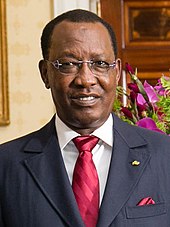
Déby attempted to reconcile the rebel groups and reintroduced multiparty politics. Chadians approved a
In 2006 Déby won
Chad is currently one of the leading partners in a
Geography
Chad is a large landlocked country spanning north-central
Chad is bounded to the north by Libya, to the east by Sudan, to the west by Niger, Nigeria and Cameroon, and to the south by the Central African Republic. The country's capital is 1,060 kilometres (660 mi) from the nearest seaport, Douala, Cameroon.[45][48] Because of this distance from the sea and the country's largely desert climate, Chad is sometimes referred to as the "Dead Heart of Africa".[49]
The dominant physical structure is a wide basin bounded to the north and east by the Ennedi Plateau and Tibesti Mountains, which include Emi Koussi, a dormant volcano that reaches 3,414 metres (11,201 ft) above sea level. Lake Chad, after which the country is named (and which in turn takes its name from the Kanuri word for "lake"[50]), is the remains of an immense lake that occupied 330,000 square kilometres (130,000 sq mi) of the Chad Basin 7,000 years ago.[45] Although in the 21st century it covers only 17,806 square kilometres (6,875 sq mi), and its surface area is subject to heavy seasonal fluctuations,[51] the lake is Africa's second largest wetland.[52]
Chad is home to six terrestrial ecoregions:
Each year a tropical weather system known as the intertropical front crosses Chad from south to north, bringing a wet season that lasts from May to October in the south, and from June to September in the Sahel.[55] Variations in local rainfall create three major geographical zones. The Sahara lies in the country's northern third. Yearly precipitations throughout this belt are under 50 millimetres (2.0 in); only occasional spontaneous palm groves survive, all of them south of the Tropic of Cancer.[48]
The Sahara gives way to a Sahelian belt in Chad's centre; precipitation there varies from 300 to 600 mm (11.8 to 23.6 in) per year. In the Sahel, a steppe of thorny bushes (mostly acacias) gradually gives way to the south to East Sudanian savanna in Chad's Sudanese zone. Yearly rainfall in this belt is over 900 mm (35.4 in).[48]
Wildlife

Chad's animal and plant life correspond to the three climatic zones. In the Saharan region, the only flora is the date-palm groves of the oasis. Palms and
Elephants, lions, buffalo, hippopotamuses, rhinoceroses, giraffes, antelopes, leopards, cheetahs, hyenas, and many species of snakes are found here, although most large carnivore populations have been drastically reduced since the early 20th century.[56][58] Elephant poaching, particularly in the south of the country in areas such as Zakouma National Park, is a severe problem. The small group of surviving West African crocodiles in the Ennedi Plateau represents one of the last colonies known in the Sahara today.[59]
Chad had a 2018 Forest Landscape Integrity Index mean score of 6.18/10, ranking it 83rd globally out of 172 countries.[60] Extensive deforestation has resulted in loss of trees such as acacias, baobab, dates and palm trees. This has also caused loss of natural habitat for wild animals; one of the main reasons for this is also hunting and livestock farming by increasing human settlements. Populations of animals like lions, leopards and rhino have fallen significantly.[61]
Efforts have been made by the Food and Agriculture Organization to improve relations between farmers, agro-pastoralists and pastoralists in the Zakouma National Park (ZNP), Siniaka-Minia, and Aouk reserve in southeastern Chad to promote sustainable development.[62] As part of the national conservation effort, more than 1.2 million trees have been replanted to check the advancement of the desert, which incidentally also helps the local economy by way of financial return from acacia trees, which produce gum arabic, and also from fruit trees.[61]
Poaching is a serious problem in the country, particularly of elephants for the profitable ivory industry and a threat to lives of rangers even in the national parks such as Zakouma. Elephants are often massacred in herds in and around the parks by organized poaching.[63] The problem is worsened by the fact that the parks are understaffed and that a number of wardens have been murdered by poachers.[64]
Demographics
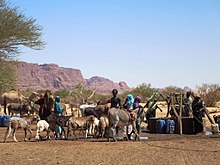
Chad's national statistical agency projected the country's 2015 population between 13,630,252 and 13,679,203, with 13,670,084 as its medium projection; based on the medium projection, 3,212,470 people lived in urban areas and 10,457,614 people lived in rural areas.[65] The country's population is young: an estimated 47% is under 15. The birth rate is estimated at 42.35 births per 1,000 people, and the mortality rate at 16.69. The life expectancy is 52 years.[66] The agency assessed the population as at mid 2017 at 15,775,400, of whom just over 1.5 million were in N'Djaména.
Chad's population is unevenly distributed. Density is 0.1/km2 (0.26/sq mi) in the Saharan
Urban life is concentrated in the capital, whose population is mostly engaged in commerce. The other major towns are Sarh, Moundou, Abéché and Doba, which are considerably smaller but growing rapidly in population and economic activity.[45] Since 2003, 230,000 Sudanese refugees have fled to eastern Chad from war-ridden Darfur. With the 172,600 Chadians displaced by the civil war in the east, this has generated increased tensions among the region's communities.[68][69]
Largest cities, towns, and municipalities
| Rank | City | Population | Region | |
|---|---|---|---|---|
| 1993 Census[72] | 2009 Census[72] | |||
| 1. | N'Djaména |
530,965 | 951,418 | N'Djaména
|
| 2. | Moundou | 99,530 | 137,251 | Logone Occidental |
| 3. | Abéché | 54,628 | 97,963 | Ouaddaï |
| 4. | Sarh | 75,496 | 97,224 | Moyen-Chari
|
| 5. | Kélo |
31,319 | 57,859 | Tandjilé
|
| 6. | Am Timan | 21,269 | 52,270 | Salamat
|
| 7. | Doba | 17,920 | 49,647 | Logone Oriental
|
| 8. | Pala | 26,116 | 49,461 | Mayo-Kebbi Ouest
|
| 9. | Bongor | 20,448 | 44,578 | Mayo-Kebbi Est |
| 10. | Goz Beïda | 3,083 | 41,248 | Sila |
Ethnic groups
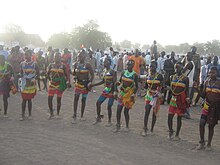
The peoples of Chad carry significant ancestry from Eastern, Central, Western, and Northern Africa.[73]
Chad has more than 200 distinct ethnic groups,[74] which create diverse social structures. The colonial administration and independent governments have attempted to impose a national society, but for most Chadians the local or regional society remains the most important influence outside the immediate family. Nevertheless, Chad's people may be classified according to the geographical region in which they live.[17][45]
In the south live sedentary people such as the
Languages
Chad's official languages are Arabic and French, but over 100 languages are spoken. The Chadic branch of the Afroasiatic language family gets its name from Chad, and is represented by dozens of languages native to the country. Chad is also home to Central Sudanic, Maban, and several Niger-Congo languages.
Due to the important role played by itinerant Arab traders and settled merchants in local communities, Chadian Arabic has become a lingua franca.[17]
Religion
Chad is a religiously diverse country. Various estimates, including from Pew Research Center in 2010, found that 52–58% of the population was Muslim, while 39–44% were Christian,
A small proportion of the population continues to practice indigenous religions. Animism includes a variety of ancestor and place-oriented religions whose expression is highly specific. Christianity arrived in Chad with the French and American missionaries; as with Chadian Islam, it syncretises aspects of pre-Christian religious beliefs.[17]
Muslims are largely concentrated in northern and eastern Chad, and animists and Christians live primarily in southern Chad and
Chad is home to foreign missionaries representing both
Education
Educators face considerable challenges due to the nation's dispersed population and a certain degree of reluctance on the part of parents to send their children to school. Although attendance is compulsory, only 68 percent of boys attend primary school, and more than half of the population is illiterate. Higher education is provided at the University of N'Djamena.[45][74] At 33 percent, Chad has one of the lowest literacy rates of Sub-Saharan Africa.[82]
In 2013, the
Government and politics
This section needs to be updated. (January 2024) |
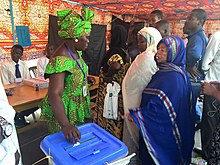
Chad's constitution provides for a strong executive branch headed by a president who dominates the political system. The president has the power to appoint the
Chad's legal system is based on
The National Assembly makes legislation. The body consists of 155 members elected for four-year terms who meet three times per year. The Assembly holds regular sessions twice a year, starting in March and October, and can hold special sessions when called by the prime minister. Deputies elect a National Assembly president every two years. The president must sign or reject newly passed laws within 15 days. The National Assembly must approve the prime minister's plan of government and may force the prime minister to resign through a majority vote of no confidence. However, if the National Assembly rejects the executive branch's programme twice in one year, the president may disband the Assembly and call for new legislative elections. In practice, the president exercises considerable influence over the National Assembly through his party, the Patriotic Salvation Movement (MPS), which holds a large majority.[74]
Until the legalisation of opposition parties in 1992, Déby's MPS was the sole legal party in Chad.[74] Since then, 78 registered political parties have become active.[71] In 2005, opposition parties and human rights organisations supported the boycott of the constitutional referendum that allowed Déby to stand for re-election for a third term[88] amid reports of widespread irregularities in voter registration and government censorship of independent media outlets during the campaign.[89] Correspondents judged the 2006 presidential elections a mere formality, as the opposition deemed the polls a farce and boycotted them.[90]
Chad is listed as a failed state by the Fund for Peace (FFP). Chad had the seventh-highest rank in the Fragile States Index in 2021.[91] Corruption is rife at all levels; Transparency International's Corruption Perceptions Index for 2021 ranked Chad 164th among the 180 countries listed.[92] Critics of former President Déby had accused him of cronyism and tribalism.[93]
In southern Chad, bitter conflicts over land are becoming more and more common. They frequently turn violent. Long-standing community culture is being eroded – and so are the livelihoods of many farmers.[94]
Longtime Chad President
Internal opposition and foreign relations
Déby faced armed opposition from groups who are deeply divided by leadership clashes but were united in their intention to overthrow him.
There have been numerous rebel groups in Chad throughout the last few decades. In 2007, a peace treaty was signed that integrated
The UAE foreign
Military
The CIA World Factbook estimates the military budget of Chad to be 4.2% of GDP as of 2006.
Administrative divisions
Since 2012 Chad has been divided into 23 regions.[110] The subdivision of Chad in regions came about in 2003 as part of the decentralisation process, when the government abolished the previous 14 prefectures. Each region is headed by a presidentially appointed governor. Prefects administer the 61 departments within the regions.[111] The departments are divided into 200 sub-prefectures, which are in turn composed of 446 cantons.[112][113]
The cantons are scheduled to be replaced by communautés rurales, but the legal and regulatory framework has not yet been completed.[114] The constitution provides for decentralised government to compel local populations to play an active role in their own development.[115] To this end, the constitution declares that each administrative subdivision be governed by elected local assemblies,[116] but no local elections have taken place,[117] and communal elections scheduled for 2005 have been repeatedly postponed.[71]
| No. | Region | Pop'n (2009) |
Pop'n (1 July 2023) |
Est. Area (km2) |
Capital | Departments |
|---|---|---|---|---|---|---|
| 1 | Batha | 488,458 | 748,395 | 93,732 | Ati | Batha Est, Batha Ouest, Fitri |
| 22 | Chari-Baguirmi | 578,425 | 884,924 | 47,226 | Massenya | Baguirmi, Chari, Loug Chari |
| 23 | Hadjer-Lamis | 566,858 | 870,231 | 31,376 | Massakory | Dababa, Dagana , Haraze Al Biar |
| 5 | Wadi Fira | 508,383 | 792,394 | 56,362 | Biltine | Dar Tama, Kobé
|
| 2 | Bahr el Gazel | 257,267 | 407,256 | 58,525 | Moussoro | Barh El Gazel Sud
|
| 3 | Borkou | 93,584 | 154,865 | 271,513 | Faya-Largeau | Borkou, Borkou Yala |
| 8 | Ennedi-Est | 107,302 | 175,321 | 81,696 | Am-Djarass |
Am-Djarass, Wadi Hawar |
| 12 | Ennedi-Ouest | 60,617 | 109,753 | 117,686 | Fada | Fada, Mourtcha |
| 9 | Guéra | 538,359 | 824,161 | 62,678 | Mongo | Guéra, Mangalmé
|
| 13 | Kanem | 333,387 | 505,839 | 70,516 | Mao | Kanem, Nord Kanem, Wadi Bissam
|
| 14 | Lac | 331,496 | 509,258 | 20,543 | Bol | Mamdi, Wayi |
| 11 | Logone Occidental | 689,044 | 1,053,958 | 8,969 | Moundou | Dodjé, Guéni, Lac Wey, Ngourkosso |
| 7 | Logone Oriental | 779,339 | 1,184,567 | 24,119 | Doba | |
| 15 | Mandoul | 628,065 | 1,002,346 | 17,761 | Koumra | Barh Sara, Mandoul Occidental, Mandoul Oriental |
| 6 | Mayo-Kebbi Est | 774,782 | 1,179,260 | 18,458 | Bongor | Mont d'Illi
|
| 10 | Mayo-Kebbi Ouest | 564,470 | 858,593 | 12,787 | Pala | Lac Léré, Mayo-Dallah |
| 19 | Moyen-Chari | 588,008 | 902,311 | 42,307 | Sarh | Barh Kôh, Grande Sido, Lac Iro |
| 4 | Ouaddaï | 721,166 | 1,102,467 | 30,790 | Abéché | Assoungha, Ouara
|
| 17 | Salamat | 302,301 | 470,256 | 69,631 | Am Timan | Aboudeïa, Barh Azoum, Haraze-Mangueigne |
| 18 | Sila | 387,461 | 591,300 | 36,745 | Goz Beïda | Djourf Al Ahmar, Kimiti
|
| 20 | Tandjilé | 661,906 | 1,007,812 | 17,891 | Laï | Tandjilé Est, Tandjilé Ouest |
| 21 | Tibesti | 25,483 | 52,626 | 135,896 | Bardaï |
Tibesti Est, Tibesti Ouest |
| 16 | N'Djamena (capital) | 951,418 | 1,434,592 | 408 | N'Djamena | 10 dawāʾir or arrondissements |
Economy
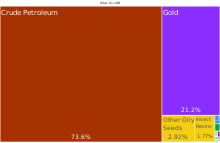

The United Nations'
Chad's currency is the

Uneven inclusion in the global political economy as a site for colonial resource extraction (primarily cotton and crude oil), a global economic system that does not promote nor encourage the development of Chadian industrialization,[119] and the failure to support local agricultural production has meant that the majority of Chadians live in daily uncertainty and hunger.[120][121] Over 80% of Chad's population relies on subsistence farming and livestock raising for its livelihood.[46] The crops grown and the locations of herds are determined by the local climate. In the southernmost 10% of the territory lies the nation's most fertile cropland, with rich yields of sorghum and millet. In the Sahel only the hardier varieties of millet grow, and with much lower yields than in the south. On the other hand, the Sahel is ideal pastureland for large herds of commercial cattle and for goats, sheep, donkeys and horses. The Sahara's scattered oases support only some dates and legumes.[17] Chad's cities face serious difficulties of municipal infrastructure; only 48% of urban residents have access to potable water and only 2% to basic sanitation.[45][114]
Before the development of oil industry, cotton dominated industry and the labour market accounted for approximately 80% of export earnings. are dominant.
According to the United Nations, Chad has been affected by a humanitarian crisis since at least 2001. As of 2008[update], the country of Chad hosts over 280,000 refugees from the Sudan's Darfur region, over 55,000 from the Central African Republic, as well as over 170,000 internally displaced persons.[123] In February 2008 in the aftermath of the Battle of N'Djamena, UN Under-Secretary-General for Humanitarian Affairs John Holmes expressed "extreme concern" that the crisis would have a negative effect on the ability of humanitarians to deliver life-saving assistance to half a million beneficiaries, most of whom – according to him – heavily rely on humanitarian aid for their survival.[124] UN spokesperson Maurizio Giuliano stated to The Washington Post: "If we do not manage to provide aid at sufficient levels, the humanitarian crisis might become a humanitarian catastrophe".[125] In addition, organizations such as Save the Children have suspended activities due to killings of aid workers.[126]
Chad has made some progress in reducing poverty, there was a decline in the national poverty rate from 55% to 47% between 2003 and 2011. However, the amount of poor people increased from 4.7 million (2011) to 6.5 million (2019) in absolute amounts. By 2018, 4.2 out of 10 people still live below the poverty line.[127]
Infrastructure
Transport
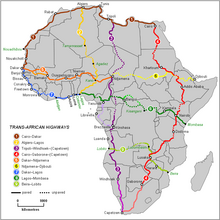
Three trans-African automobile routes pass through Chad:
- the Tripoli-Cape Town Highway(3)
- the Dakar-Ndjamena Highway(5)
- the Ndjamena-Djibouti Highway(6)
Civil war crippled the development of transport infrastructure; in 1987, Chad had only 30 kilometres (19 mi) of paved roads. Successive road rehabilitation projects improved the network[128] to 550 kilometres (340 mi) by 2004.[129] Nevertheless, the road network is limited; roads are often unusable for several months of the year. With no railways of its own, Chad depends heavily on Cameroon's rail system for the transport of Chadian exports and imports to and from the seaport of Douala.[130]
As of 2013[update] Chad had an estimated 59 airports, only 9 of which had paved runways.[131] An international airport serves the capital and provides regular nonstop flights to Paris and several African cities.
Energy
Chad's energy sector has had years of mismanagement by the parastatal Chad Water and Electric Society (STEE), which provides power for 15% of the capital's citizens and covers only 1.5% of the national population.[132] Most Chadians burn biomass fuels such as wood and animal manure for power.[133]
Telecommunications
The
Gateway Communications, a pan-African wholesale connectivity and telecommunications provider also has a presence in Chad.[135] In September 2013, Chad's Ministry for Posts and Information & Communication Technologies (PNTIC) announced that the country will be seeking a partner for fiber optic technology.
Chad is ranked last in the World Economic Forum's Network Readiness Index (NRI) – an indicator for determining the development level of a country's information and communication technologies. Chad ranked number 148 out of 148 overall in the 2014 NRI ranking, down from 142 in 2013.[136] In September 2010 the mobile phone penetration rate was estimated at 24.3% over a population estimate of 10.7 million.[137]
Culture
Because of its great variety of peoples and languages, Chad possesses a rich cultural heritage. The Chadian government has actively promoted Chadian culture and national traditions by opening the
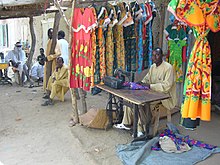
Cuisine
Millet is the staple food of Chadian cuisine. It is used to make balls of paste that are dipped in sauces. In the north this dish is known as alysh; in the south, as biya. Fish is popular, which is generally prepared and sold either as salanga (sun-dried and lightly smoked Alestes and Hydrocynus) or as banda (smoked large fish).[138] Carcaje is a popular sweet red tea extracted from hibiscus leaves. Alcoholic beverages, though absent in the north, are popular in the south, where people drink millet beer, known as billi-billi when brewed from red millet, and as coshate when from white millet.[139]
Music
The music of Chad includes a number of instruments such as the kinde, a type of bow harp; the kakaki, a long tin horn; and the hu hu, a stringed instrument that uses calabashes as loudspeakers. Other instruments and their combinations are more linked to specific ethnic groups: the Sara prefer whistles, balafons, harps and kodjo drums; and the Kanembu combine the sounds of drums with those of flute-like instruments.[139]
The music group Chari Jazz formed in 1964 and initiated Chad's modern music scene. Later, more renowned groups such as African Melody and International Challal attempted to mix modernity and tradition. Popular groups such as Tibesti have clung faster to their heritage by drawing on sai, a traditional style of music from southern Chad. The people of Chad have customarily disdained modern music. However, in 1995 greater interest has developed and fostered the distribution of CDs and audio cassettes featuring Chadian artists. Piracy and a lack of legal protections for artists' rights remain problems to further development of the Chadian music industry.[139][140]
Literature

As in other Sahelian countries,
Media and cinema
Chad's television audience is limited to N'Djamena. The only television station is the state-owned Télé Tchad. Radio has a far greater reach, with 13 private radio stations.[143] Newspapers are limited in quantity and distribution, and circulation figures are small due to transportation costs, low literacy rates, and poverty.[89][133][144] While the constitution defends liberty of expression, the government has regularly restricted this right, and at the end of 2006 began to enact a system of prior censorship on the media.[145]
The development of a
Sports
See also
Notes
References
Citations
- ^ "Analyse Thematique des Resultats Definitifs Etat et Structures de la Population". Institut National de la Statistique, des Études Économiques et Démographiques du Tchad. Archived from the original on 28 December 2019. Retrieved 3 May 2020.
- ^ a b "Religions in Chad | PEW-GRF". Archived from the original on 8 October 2022. Retrieved 11 August 2022.
- ^ Ramadane, Mahamat (2 October 2022). "Junta set to stay in power after Chad delays elections by two years". Reuters. N'Djamena. Retrieved 20 October 2022.
- ^ "Chad's military ruler Mahamat Deby names transitional parliament". Al Jazeera. 24 September 2021. Retrieved 19 March 2023.
- ^ a b "Le TCHAD en bref" (in French). INSEED. 22 July 2013. Archived from the original on 22 December 2015. Retrieved 18 December 2015.
- ^ "Chad". The World Factbook (2024 ed.). Central Intelligence Agency. Retrieved 22 June 2023.
- ^ a b c d e "World Economic Outlook Database, October 2023 Edition. (Chad)". IMF.org. International Monetary Fund. 10 October 2023. Retrieved 18 October 2023.
- ^ "Gini Index". World Bank. Retrieved 15 July 2022.
- ^ "Human Development Report 2023/24" (PDF). United Nations Development Programme. 13 March 2024. Retrieved 13 March 2024.
- ^ "Glottolog 4.8 - Languages of Chad". glottolog.org. Retrieved 15 August 2023.
- ^ a b "Enquête Démographique et de Santé 1996–1997" (PDF). Archived (PDF) from the original on 9 October 2022.
- ^ "Chad's authoritarian Deby unwilling to quit". Deutsche Welle. 8 April 2016. Retrieved 4 August 2020.
- ^ Haynes, Suyin (28 March 2019). "This African Country Has Had a Yearlong Ban on Social Media. Here's What's Behind the Blackout". Time. Retrieved 4 August 2020.
- ^ Werman, Marco (5 June 2012). "ExxonMobil and Chad's Authoritarian Regime: An 'Unholy Bargain'". The World. Public Radio International. Retrieved 4 August 2020.
- ^ a b Ramadane, Madjiasra Nako, Mahamat (21 April 2021). "Chad in turmoil after Deby death as rebels, opposition challenge military". Reuters. Retrieved 21 April 2021.
{{cite news}}: CS1 maint: multiple names: authors list (link) - ^ Decalo, pp. 44–45
- ^ a b c d e f g h i S. Collelo, Chad
- ^ D. Lange 1988
- ^ Decalo, p. 6
- ^ Decalo, pp. 7–8
- ^ "Welcome to Encyclopædia Britannica's Guide to Black History". Encyclopædia Britannica. Archived from the original on 6 October 2014. Retrieved 29 August 2010.
- ^ Decalo, pp. 8, 309
- ^ a b Decalo, pp. 8–9
- ^ Decalo, p. 53
- ^ Decalo, pp. 248–249
- ^ Nolutshungu, p. 17
- ^ "Death of a Dictator", Time, (28 April 1975). Accessed on 3 September 2007.
- ^ Decalo, pp. 12–16
- ^ Nolutshungu, p. 268
- ^ Nolutshungu, p. 150
- ^ Nolutshungu, p. 230
- ISBN 0-8032-3733-2, pp. 391–397
- ISBN 0-8122-1950-3, pp. 133–134
- ^ "Chad: the Habré Legacy" Archived 13 January 2015 at the Wayback Machine. Amnesty International. 16 October 2001.
- ^ Nolutshungu, pp. 234–237
- ^ "Chad ex-leader Habre charged in Senegal with war crimes". BBC. 2 July 2013. Retrieved 2 July 2013.
- ^ "Hissène Habré: Chad's ex-ruler convicted of crimes against humanity". BBC. 2016.
- ISBN 1-85743-126-X, p. 100
- ^ IPS, "Le pétrole au cœur des nouveaux soubresauts au Tchad"
- ^ Chad may face genocide, UN warns. BBC News, 16 February 2007
- ^ "Chad's leader asserts he controls". USA Today. Associated Press. 6 February 2008.
- ^ World Report 2011: Chad. Human Rights Watch. 24 January 2011. Archived from the original on 28 August 2012. Retrieved 6 June 2011.
- ^ "Chad government foils coup attempt – minister". Reuters. 2013.
- ^ a b "Chad's president Idriss Déby dies 'in clashes with rebels'". BBC News. 20 April 2021. Retrieved 20 April 2021.
- ^ a b c d e f g h i j k "Chad". Encyclopædia Britannica. (2000)
- ^ a b c d CIA, "Chad", 2009
- ^ "Rank Order – Area Archived 9 February 2014 at the Wayback Machine". The World Factbook. United States Central Intelligence Agency.
- ^ a b c d "Chad". Human Rights Instruments. United Nations Commission on Human Rights. 12 December 1997.
- .
- ISBN 978-1-4331-2926-1, p. 59.
- ^ "Chad, Lake". Encyclopædia Britannica. (2000).
- ISBN 0-8213-3321-6, p. 57
- PMID 28608869.
- ISBN 2-85802-169-4, pp. 10–16
- ^ Decalo, p. 3
- ^ a b "Important Bird Areas in Africa and associated islands – Chad" (PDF). Birdlife International Organization. Archived from the original (PDF) on 11 September 2016. Retrieved 16 October 2013.
- PMID 23805051. Retrieved 17 October 2013.
- ^ "Plant and Animal Life". The Living Africa. Archived from the original on 28 December 2013. Retrieved 17 October 2013.
- PMID 21364897.
- PMID 33293507.
- ^ a b "Our Africa". Our Africa organization. Retrieved 17 October 2013.
- ^ "Livestock-wildlife-environment interactions in Chad". Food and Agriculture Organization. Archived from the original on 19 October 2013. Retrieved 17 October 2013.
- ^ "African Elephants Slaughtered in Herds Near Chad Wildlife Park". National Geographic. 30 August 2006. Archived from the original on 17 October 2013. Retrieved 17 October 2013.
- ^ "Rangers in Isolated Central Africa Uncover Grim Cost of Protecting Wildlife". The New York Times. 31 December 2012. Retrieved 17 October 2013.
- ^ Projections demographiques 2009–2050 Tome 1: Niveau national (PDF) (Report) (in French). INSEED. July 2014. p. 7. Archived from the original (PDF) on 22 December 2015. Retrieved 18 December 2015.
- ^ "Life expectancy at birth, total (years)". October 2016. World Bank
- ^ "Chad Livelihood Profiles" (PDF). March 2005. United States Agency for International Development.
- ^ "COMMISSION DECISION of on the financing of a Global Plan for humanitarian operations from the budget of the European Union in CHAD" (PDF). European Commission. 2008. Archived (PDF) from the original on 9 October 2022.
- Office for the Coordination of Humanitarian Affairs.
- ^ "Chad Archived 14 June 2007 at the Wayback Machine" (PDF). Women of the World: Laws and Policies Affecting Their Reproductive Lives – Francophone Africa. Center for Reproductive Rights. 2000
- ^ Country Reports on Human Rights Practices 2006, 6 March 2007. Bureau of Democracy, Human Rights, and Labor, U.S. Department of State.
- ^ a b "INSEED-TCHAD – Document". Inseed-td.net. 24 April 2018. Archived from the original on 28 December 2019. Retrieved 24 May 2020.
- PMID 27889059.
- ^ a b c d e f g h i "Background Note: Chad ". September 2006. United States Department of State.
- ^ "Table: Christian Population as Percentages of Total Population by Country". Pew Research Center. 19 December 2011. Archived from the original on 11 May 2017. Retrieved 16 April 2018.
- ^ "Table: Muslim Population by Country". Pew Research Center. 27 January 2011. Retrieved 16 April 2018.
- ^ "The World's Muslims: Unity and Diversity" (PDF). Pew Forum on Religious & Public life. 9 August 2012. pp. 128–129. Archived from the original (PDF) on 24 October 2012. Retrieved 2 June 2014.
- ^ a b c d "Religious demographics (Chad)". Association of Religion Data Archives. 2020. Retrieved 29 September 2022.
- ^ a b c d "Chad". International Religious Freedom Report 2006. 15 September 2006. Bureau of Democracy, Human Rights, and Labor, U.S. Department of State.
- ^ a b "2021 Report on International Religious Freedom: Chad". United States Department of State. Retrieved 29 September 2022.
- ^ Pew Research Center's Religion & Public Life Project: Chad. Pew Research Center. 2010.
- ^ "50 Things You Didn't Know About Africa" (PDF). World Bank. Archived from the original (PDF) on 25 July 2013. Retrieved 7 May 2012.
- ^ "Findings on the Worst Forms of Child Labor – Chad". Archived from the original on 25 April 2015. Retrieved 29 June 2015.
- ^ "List of Goods Produced by Child Labor or Forced Labor". Archived from the original on 10 June 2015. Retrieved 29 June 2015.
- ^ "Chad 1996 (rev. 2005)". Constitute. Retrieved 22 April 2015.
- ^ a b "Chad votes to end two-term limit". BBC News. 22 June 2005. Retrieved 20 September 2007.
- ^ a b "Republic of Chad – Public Administration Country Profile Archived 14 June 2007 at the Wayback Machine" (PDF). United Nations, Department of Economic and Social Affairs. November 2004.
- ^ "Chad" Archived 13 January 2015 at the Wayback Machine. Amnesty International Report 2006. Amnesty International Publications.
- ^ a b "Chad (2006)". Archived from the original on 4 June 2011. Retrieved 19 June 2007.. Freedom of the Press: 2007 Edition. Freedom House, Inc.
- ^ "Chad leader's victory confirmed", BBC News, 14 May 2006.
- ^ "Fragile States Index | The Fund for Peace". fragilestatesindex.org. Retrieved 11 August 2021.
- ^ "Corruption Perceptions Index (latest)". Transparency International. Retrieved 11 August 2022.
- ^ "Isolated Deby clings to power". BBC News. 13 April 2006. Retrieved 4 September 2007.
- ^ Djeralar Miankeol (17 June 2017). "Commercialisation is destroying community rules". D+C, development and cooperation. Retrieved 15 August 2017.
- ^ "Chad President Idriss Deby killed on frontline, son to take over". Thomas Reuters News. Reuters. 20 April 2021. Archived from the original on 22 April 2021. Retrieved 20 April 2021.
- ^ "Chad Sets Up Transitional Military Council Headed By Son Of Late President – Reports". UrduPoint. Retrieved 20 April 2021.
- ^ "Chad President Idriss Deby dies on front lines, according to an army statement". Deutsche Welle. 20 April 2021. Retrieved 20 April 2021.
- ^ "Calm and order in Chad three months after Idriss Déby's death". Africanews. 19 July 2021. Retrieved 10 August 2021.
- ^ V-Dem Institute (2023). "The V-Dem Dataset". Retrieved 14 October 2023.
- ^ (in French) "Tchad: vers le retour de la guerre? Archived 5 September 2011 at the Wayback Machine" (PDF). International Crisis Group. 1 June 2006.
- ^ Wolfe, Adam; "Instability on the March in Sudan, Chad and Central African Republic". Archived from the original on 5 January 2007. Retrieved 19 June 2007., PINR, 6 December 2006.
- ^ Manley, Andrew; "Chad's vulnerable president", BBC News, 15 March 2006.
- ^ Human Rights Watch (2007). Early to War: Child Soldiers in the Chad Conflict. Human Rights Watch. pp. 13–.
- ^ Reeves, Eric (9 August 2008) Victims of Genocide in Darfur: Past, Present, and Future – Sudan Tribune: Plural news and views on Sudan Archived 22 April 2014 at the Wayback Machine. Sudan Tribune. Retrieved on 28 September 2013.
- ^ Chad rebels say to resume fight, Deby's promises unmet Archived 24 September 2015 at the Wayback Machine. Reuters. 21 March 2013
- ^ "United Arab Emirates (UAE) Opens Coordination Office for Foreign Aid in Chad". 3 August 2023.
- ^ "UAE opens coordination office for foreign aid in Chad". 3 August 2023.
- ^ "Chad". The World Factbook (2024 ed.). Central Intelligence Agency. 29 September 2021. (Archived 2021 edition.)
- ^ "Military expenditure (% of GDP) | Data". data.worldbank.org.
- ^ Law, Gwillim. "Regions of Chad". Statoids. Retrieved 15 June 2015.
- ^ "Tableau des codes des circonscritions – Ministère de l'Intérieur", April 2008. (in French)
- ^ "Chad". Country Reports on Human Rights Practices 2004, 28 February 2005. Bureau of Democracy, Human Rights, and Labor, U.S. Department of State.
- ^ (in French) Ndang, Tabo Symphorien (2005) "A qui Profitent les Dépenses Sociales au Tchad? Une Analyse d'Incidence à Partir des Données d'Enquête Archived 12 May 2012 at the Wayback Machine" (PDF). 4th PEP Research Network General Meeting. Poverty and Economic Policy.
- ^ a b "Chad – Community Based Integrated Ecosystem Management Project" (PDF). 24 September 2002. World Bank.
- ^ (in French) "Tchad". L'évaluation de l'éducation pour tous à l'an 2000: Rapport des pays. UNESCO, Education for All.
- ^ (in French) Dadnaji, Dimrangar (1999); "La decentralisation au Tchad". Archived from the original on 8 March 2008. Retrieved 19 June 2007.
- ^ ISBN 978-92-64-02510-3
- ^ "OHADA.com: The business law portal in Africa". Retrieved 22 March 2009.
- ISBN 9780745319605.
- ISBN 9780862329310.
- ISBN 9781842778111.
- ^ Decalo, p. 11
- ^ Humanitarian Action in Chad: Facts and Figures – Snapshot Report, UN, 6 March 2008
- ^ Eastern Chad: Concerns over vital humanitarian needs (press release), UN, 7 February 2008
- ^ Timberg, Craig (6 February 2008) Chadian Rebels Urge Cease-Fire As Push Falters, The Washington Post
- ^ Crisis in Chad | Save the Children UK Archived 22 April 2014 at the Wayback Machine. Savethechildren.org.uk. Retrieved on 28 September 2013.
- ^ "The World Bank in Chad". The World Bank. 2022. Retrieved 25 May 2022.
- ^ "Chad Poverty Assessment: Constraints to Rural Development" (PDF). World Bank. 21 October 1997.
- ^ (in French) Lettre d'information Archived 24 October 2007 at the Wayback Machine (PDF). Délégation de la Commission Européenne au Tchad. N. 3. September 2004
- ISBN 92-1-104540-1
- ^ "Chad". The World Factbook (2024 ed.). Central Intelligence Agency. Retrieved 16 April 2017. (Archived 2017 edition.)
- ^ a b c Spera, Vincent (8 February 2004); "Chad Country Commercial Guide – FY 2005". Archived from the original on 15 October 2007. Retrieved 6 May 2007.. United States Department of Commerce.
- ^ a b "Chad and Cameroon". Archived from the original on 13 January 2009. Retrieved 19 June 2007.. Country Analysis Briefs. January 2007. Energy Information Administration.
- ^ World Bank (14 July 2006). World Bank, Govt. of Chad Sign Memorandum of Understanding on Poverty Reduction
- ^ Gateway expands presence in Guinea and Senegal. IT News Africa. 22 April 2010.
- ^ "NRI Overall Ranking 2014" (PDF). World Economic Forum. Archived (PDF) from the original on 9 October 2022. Retrieved 28 June 2014.
- ^ "Chad Mobile Market (Q1 2008 – Q3 2010)". mnodirectory.com. Archived from the original on 4 December 2011.
- FAO. 29 November – 1 December 1972.
- ^ ISBN 0-7727-9102-3
- ^ * (in French) Gondjé, Laoro (2003); "La musique recherche son identité Archived 22 April 2014 at the Wayback Machine", Tchad et Culture 214.
- ^ (in French) Malo, Nestor H. (2003); "Littérature tchadienne : Jeune mais riche Archived 28 September 2013 at archive.today", Tchad et Culture 214.
- ISBN 0-86543-757-2, pp. 12, 132, 135
- ^ Radio Stations | Embassy of the United States Ndjamena, Chad Archived 17 July 2007 at the Wayback Machine. Ndjamena.usembassy.gov (25 February 2013). Retrieved on 28 September 2013.
- ^ Newspapers | Embassy of the United States Ndjamena, Chad Archived 17 September 2013 at the Wayback Machine. Ndjamena.usembassy.gov (25 February 2013). Retrieved on 28 September 2013.
- ^ "Chad – 2006". Freedom Press Institute.
- ^ Dawn – Chad's only cinema dusts off its silver screen, 9 April 2011, retrieved 8 October 2019
- ^ Praveen, S. r. (9 December 2017), "The Hindu The man who brought cinema to war-hit Chad", The Hindu, retrieved 8 October 2019
- ^ White, Jerry, Vertigo – Fatherlands: On Mahamat-Saleh Haroun, Africa and an Evolving Political Cinema, archived from the original on 7 October 2020, retrieved 8 October 2019
- ^ Chang, Justin (23 May 2010). "'Uncle Boonmee' wins Palme d'Or". Variety. Archived from the original on 3 December 2012. Retrieved 23 May 2010.
- ^ (in French) Bambé, Naygotimti (April 2007); "Issa Serge Coelo, cinéaste tchadien: On a encore du travail à faire Archived 30 May 2013 at the Wayback Machine", Tchad et Culture 256.
- ^ Young, Neil (23 March 2004) An interview with Mahamet-Saleh Haroun, writer and director of Abouna ("Our Father"). jigsawlounge.co.uk
- ^ "Mirren crowned 'queen' at Venice", BBC News, 9 September 2006.
- ^ (in French) Alphonse, Dokalyo (2003) "Cinéma: un avenir plein d'espoir" Archived 28 September 2013 at archive.today, Tchad et Culture 214.
- ^ Staff (2 July 2007). "Chad". FIFA, Goal Programme. Archived from the original on 29 June 2007. Retrieved 10 August 2006.
Sources
- (in French) Alphonse, Dokalyo (2003) "Cinéma: un avenir plein d'espoir" Archived 28 September 2013 at archive.today, Tchad et Culture 214.
- "Background Note: Chad". September 2006. United States Department of State.
- (in French) Bambé, Naygotimti (April 2007); "Issa Serge Coelo, cinéaste tchadien: On a encore du travail à faire", Tchad et Culture 256.
- Botha, D.J.J. (December 1992); "S.H. Frankel: Reminiscences of an Economist", The South African Journal of Economics 60 (4): 246–255.
- Boyd-Buggs, Debra & Joyce Hope Scott (1999); Camel Tracks: Critical Perspectives on Sahelian Literatures. Lawrenceville: Africa World Press. ISBN 0-86543-757-2
- "Chad". The World Factbook (2024 ed.). Central Intelligence Agency. Retrieved 28 January 2010. (Archived 2010 edition.)
- "Chad". Country Reports on Human Rights Practices 2006, 6 March 2007. Bureau of Democracy, Human Rights, and Labor, U.S. Department of State.
- "Chad". Country Reports on Human Rights Practices 2004, 28 February 2005. Bureau of Democracy, Human Rights, and Labor, U.S. Department of State.
- "Chad". International Monetary Fund. Retrieved 18 April 2012.
- "Chad". International Religious Freedom Report 2006. 15 September 2006. Bureau of Democracy, Human Rights, and Labor, U.S. Department of State.
- "Amnesty International Report 2006 Archived 13 January 2015 at the Wayback Machine". Amnesty International Publications.
- "Chad" (PDF). African Economic Outlook 2007. ISBN 978-92-64-02510-3
- "Chad". The World Factbook. United States Central Intelligence Agency. 15 May 2007.
- "Chad" (PDF). Women of the World: Laws and Policies Affecting Their Reproductive Lives – Francophone Africa. Center for Reproductive Rights. 2000
- "Chad (2006)". Archived from the original on 4 June 2011. Retrieved 6 May 2007.. Freedom of the Press: 2007 Edition. Freedom House, Inc.
- "Chad". Human Rights Instruments. United Nations Commission on Human Rights. 12 December 1997.
- "Chad". Encyclopædia Britannica. (2000). Chicago: Encyclopædia Britannica, Inc.
- "Chad, Lake". Encyclopædia Britannica. (2000).
- "Chad – Community Based Integrated Ecosystem Management Project" (PDF). 24 September 2002. World Bank.
- "Chad: A Cultural Profile" (PDF). Archived from the original (PDF) on 1 October 2006. Retrieved 4 June 2007. (PDF). Cultural Profiles Project. ISBN 0-7727-9102-3
- "Chad Urban Development Project" (PDF). 21 October 2004. World Bank.
- "Chad: Humanitarian Profile – 2006/2007" (PDF). 8 January 2007. Office for the Coordination of Humanitarian Affairs.
- "Chad Livelihood Profiles" (PDF). March 2005. United States Agency for International Development.
- "Chad Poverty Assessment: Constraints to Rural Development" (PDF). World Bank. 21 October 1997.
- "Chad (2006) Archived 12 October 2007 at the Wayback Machine". Country Report: 2006 Edition. Freedom House, Inc.
- "Chad and Cameroon". Archived from the original on 13 January 2009. Retrieved 17 May 2007.. Country Analysis Briefs. January 2007. Energy Information Administration.
- "Chad leader's victory confirmed", BBC News, 14 May 2006.
- "Chad may face genocide, UN warns", BBC News, 16 February 2007.
- (in French) Chapelle, Jean (1981); Le Peuple Tchadien: ses racines et sa vie quotidienne. Paris: L'Harmattan. ISBN 2-85802-169-4
- ISBN 92-1-104540-1
- Collelo, Thomas (1990); Chad: A Country Study, 2d ed. Washington: ISBN 0-16-024770-5
- (in French) Dadnaji, Dimrangar (1999); "La decentralisation au Tchad". Archived from the original on 8 March 2008. Retrieved 19 June 2007.
- Decalo, Samuel (1987). Historical Dictionary of Chad (2 ed.). Metuchen: The Scarecrow Press. ISBN 978-0-8108-1937-5.
- East, Roger & Richard J. Thomas (2003); Profiles of People in Power: The World's Government Leaders. Routledge. ISBN 1-85743-126-X
- Dinar, Ariel (1995); Restoring and Protecting the World's Lakes and Reservoirs. World Bank Publications. ISBN 0-8213-3321-6
- (in French) Gondjé, Laoro (2003); "La musique recherche son identité", Tchad et Culture 214.
- "Chad: the Habré Legacy" Archived 13 January 2015 at the Wayback Machine. Amnesty International. 16 October 2001.
- Lange, Dierk (1988). "The Chad region as a crossroad" (PDF), in UNESCO ISBN 978-0-520-03914-8
- (in French) Lettre d'information (PDF). Délégation de la Commission Européenne au Tchad. N. 3. September 2004.
- Macedo, Stephen (2006); Universal Jurisdiction: National Courts and the Prosecution of Serious Crimes Under International Law. University of Pennsylvania Press. ISBN 0-8122-1950-3
- (in French) Malo, Nestor H. (2003); "Littérature tchadienne : Jeune mais riche", Tchad et Culture 214.
- Manley, Andrew; "Chad's vulnerable president", BBC News, 15 March 2006.
- "Mirren crowned 'queen' at Venice", BBC News, 9 September 2006.
- (in French) Ndang, Tabo Symphorien (2005); "A qui Profitent les Dépenses Sociales au Tchad? Une Analyse d'Incidence à Partir des Données d'Enquête Archived 12 May 2012 at the Wayback Machine" (PDF). 4th PEP Research Network General Meeting. Poverty and Economic Policy.
- ISBN 978-0-8139-1628-6.
- ISBN 0-8032-3733-2
- "Rank Order – Area Archived 9 February 2014 at the Wayback Machine". The World Factbook. United States Central Intelligence Agency. 10 May 2007.
- "Republic of Chad – Public Administration Country Profile Archived 14 June 2007 at the Wayback Machine" (PDF). United Nations, Department of Economic and Social Affairs. November 2004.
- "Circonscriptions Administratives" (PDF) (in French). Government of Chad. 3 July 2007. Archived from the original (PDF) on 3 July 2007.
- Spera, Vincent (8 February 2004); "Chad Country Commercial Guide – FY 2005". Archived from the original on 15 October 2007. Retrieved 6 May 2007.. United States Department of Commerce.
- "Symposium on the evaluation of fishery resources in the development and management of inland fisheries". CIFA Technical Paper No. 2. FAO. 29 November – 1 December 1972.
- (in French) "Tchad". L'évaluation de l'éducation pour tous à l'an 2000: Rapport des pays. UNESCO, Education for All.
- (in French) "Tchad: vers le retour de la guerre?" (PDF). International Crisis Group. 1 June 2006.
- Wolfe, Adam; "Instability on the March in Sudan, Chad and Central African Republic". Archived from the original on 5 January 2007. Retrieved 3 May 2007., PINR, 6 December 2006.
- World Bank (14 July 2006). World Bank, Govt. of Chad Sign Memorandum of Understanding on Poverty Reduction. Press release.
- World Population Prospects: The 2006 Revision Population Database. 2006. United Nations Population Division.
- "Worst corruption offenders named", BBC News, 18 November 2005.
- Young, Neil (August 2002); An interview with Mahamet-Saleh Haroun, writer and director of Abouna ("Our Father").
External links
- Chad. The World Factbook. Central Intelligence Agency.
- Chad country study from Library of Congress
- Chad web resources provided by GovPubs at the University of Colorado Boulder Libraries
- Chad at Curlie
- Chad profile from the BBC News
 Wikimedia Atlas of Chad
Wikimedia Atlas of Chad Geographic data related to Chad at OpenStreetMap
Geographic data related to Chad at OpenStreetMap- Key Development Forecasts for Chad from International Futures




